The Mystery and Wonder of our Old First Chandelier
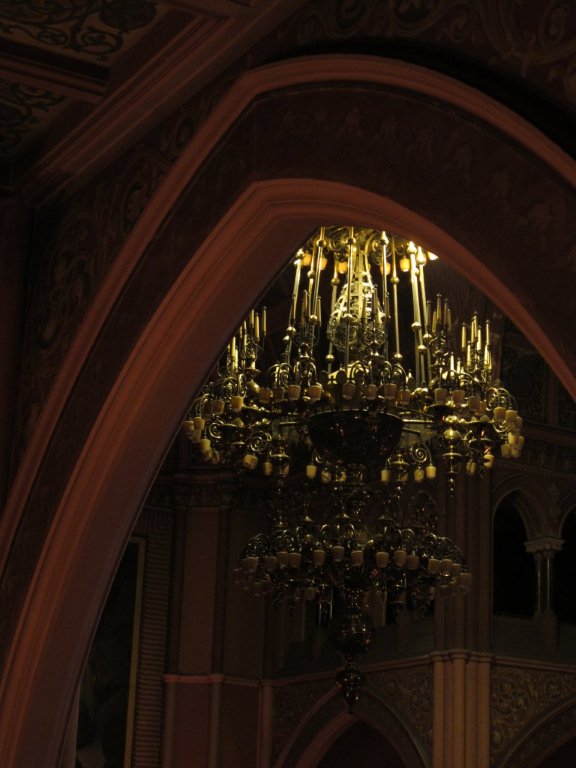
Old First sanctuary chandelier. Photo by Jane Hively Barber.
“One of the contractors who put a bid on the ceiling restoration said to me, ‘this church has secrets still to be discovered.’”
That quote from Pastor Daniel Meeter confirmed what we had suspected all along. Our sanctuary chandelier is as mysterious as it is beautiful, with a hazy, unclear past.
“We don’t know who made it,” Pastor Meeter says. “We don’t know when it was first reconditioned. We don’t know just how remarkable it is.”
What we do know: it was created in the 19th century, when chandeliers were lit with both gas and electric power. Up until the 1880s, all interior lighting was powered by gas. Around 1879, Edison created the first electric light bulb. He put it on the market in 1881. Within nine years, we have our Old First chandelier. To put it in perspective: there was no electric power in Brooklyn until 1885-1886.
“We take electricity for granted,” Pastor Meeter says, “but back when this chandelier was hung, electricity was avant garde; it was brand new. Gas is what they believed in. To have this newfangled electric thing is just remarkable.”
Pastor Meeter estimates that our chandelier was designed in 1889. His reason: that’s about the time when the architect began work on the building.
“This chandelier was a remarkable attempt at a glorious monument to a new invention,” he says. “We don’t even know what the first sockets of the bulbs were, because the bulbs that we take for granted today came later. And this was originally direct current [DC]. Today, we have alternating current [AC]. There were vacuum bulbs with little tips on the ends because they’re blown glass. The glass shades were also different. The gas is what gave the brightness. The electricity was not nearly as bright as the gas.”
The sheer size of it is also confounding. Pastor Meeter says that, in his research, he could not find any similar chandelier of that size.
Here is some backstory: For most of human history, chandeliers were lit by candles. The word itself if taken from the French word for candle. Gas was introduced into American interiors in the 1840s and 1850s — this was the same time that gas-powered chandeliers (gasoliers) were introduced. Gas would be piped into buildings by the gas company.
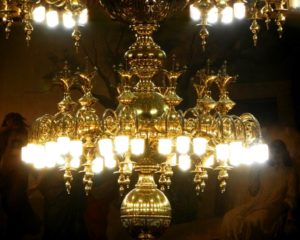
Old First sanctuary chandelier. Photo by Jane Hively Barber.
Our chandelier was officially called an “electro-gasolier.” It was considered high tech. This model would be used for about thirty years, eventually replaced in the 20th century — most likely the 1920s — exclusively by electricity.
Of course, the aesthetic component is just as powerful. The chandelier is all brass.
“We don’t know if it was made by machine or by hand,” Pastor Meeter says. “We don’t know how it was made because we don’t have anything like it anymore. If you think about it, the Brooklyn Bridge was put up by hand, in a way that no one would build the Brooklyn Bridge today. It was done without certain machines that we now take for granted.”
So what we have is an electro-gasolier with many intricate brass parts. Tubes transport the gas, and conduits transport the electricity.
Then it gets even more astounding:
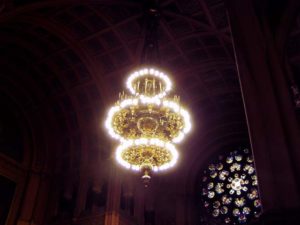
Old First sanctuary chandelier with rose window in the background. Photo by Lois Wingerson
“Because it was so high up, you had to add ignition wires running from the gas jets to provide electrical sparks, to light the thing,” Pastor Meeter says. “The tip of some of the gas jets were called mantels, cotton webbing that burn to ash or keep their shape. They provided even more light, because they glow.”
How else does the chandelier use its power to transfix us?
“It draws your sight up,” Pastor Meeter says. “It’s almost like an elevator of your emotional energy. Because it fills that center space with light and with burnished brass color, it just raises everything. It’s not just that there is light shining down. It pulls your emotional energy up and makes the building seem even higher. It moves the energy to the center of the sanctuary and up. In a Roman Catholic church, there is more of a horizontal focus, toward the altar. Your focus there is horizontal. In our sanctuary, it’s almost the same effect as a dome. It brings a lofty center to the room. There is a lot of intentionality of design.”
Included in that intentionality are the smaller parts that make up the whole.
“All the components have smaller elements of the chandelier.” he says. “They are almost like baby fish. What I mean is that the chandelier is the mother ship, with little ships around it. You can pick up certain details in the sconces, in the small lights, in the corners. But it’s in the chandelier that it’s all gloriously together.”
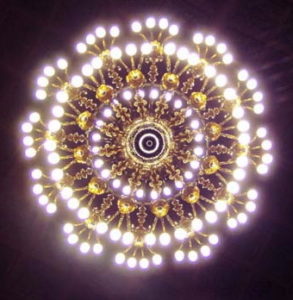
Old First sanctuary chandelier from below. Photo by Lois Wingerson
We also know that it must have been custom made, because there are four-inch bras belts (bands) that are shaped like big hoops. They each feature leaf etchings, and these same etchings are found in the walls and even on one of the stained-glass windows.
Although it had been lowered periodically for bulb replacement and cleaning, the last time the chandelier received official maintenance was in 2007. A group from Wisconsin traveled here specifically for the task. They cleaned the entire chandelier and replaced all the incandescent bulbs with brighter ones.
For whatever reason, those bulbs started to burn out within a couple of years.
“When we raised it, a piece of plaster fell,” Pastor Meeter says, “but we thought it was just one piece of plaster. You can tell it had been loose anyway for years. We rebulbed it again in 2009 or 2010. We talked about rewiring it but we knew so little about it. We think that the movement of the chandelier stressed the plaster, which caused it to fall at the crossing. When we inspected that, we found that there were other pieces loose as well, and that’s when we closed the sanctuary down.”
Since Pastor Meeter came to Old First in 2001, the chandelier had been lowered three times. This third time, we’re going to look into the archeology and the history, and we’re going to do the research.
“We’re now at the stage where instead of just doing patchwork, and working out of ignorance, we’re going to learn about this,” he says. “This time we are going to really address it.”
This is also the first time we are able to reach the top of the chandelier. For the last two lowerings, we never had scaffolding high enough to get to the top.
“One of things we are going to have to do is look inside it to see if there are identifying marks — who made it,” Pastor Meeter says. “I haven’t been able to find any brand marks or trademarks on there. We’ll do some inspection work from the scaffolding at the top, and we will redo whatever wiring we have to redo.”
In the meantime, Milan Restoration, the company working on the improvements, will build a box around the chandelier to protect it during the work (they are doing the same for the pipe organ).
We’ll keep you posted on what mysteries we solve.
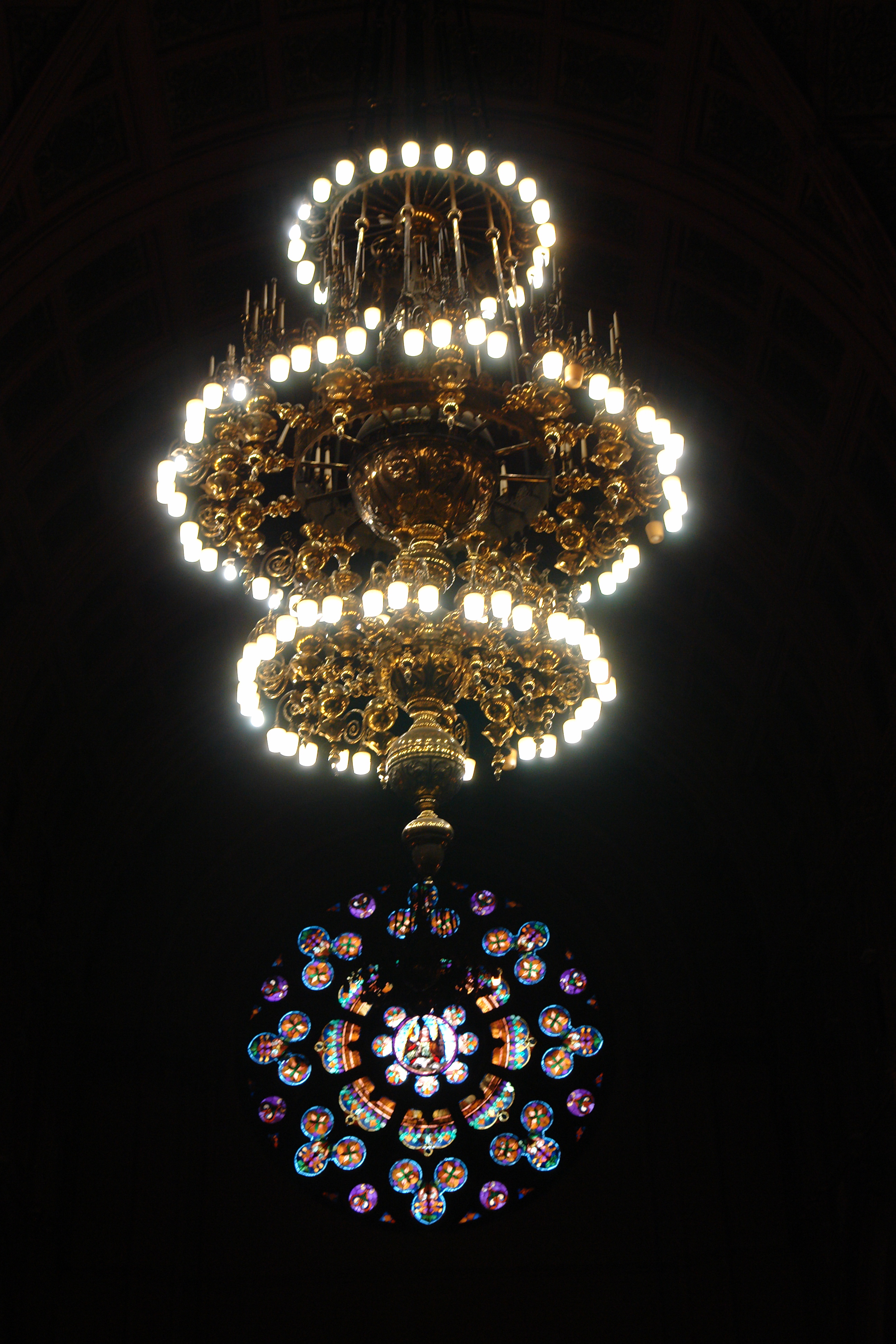
Old First sanctuary chandelier with rose window in the background. Photo by Karen Singh Ebenezer.
